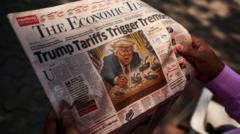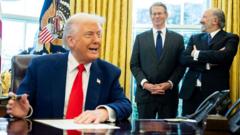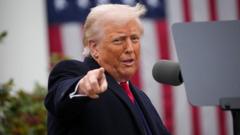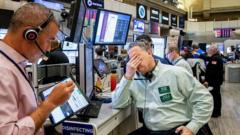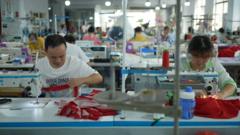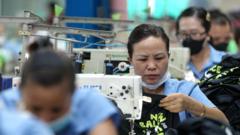The latest GDP figures show a troubling slowdown in India's economy, dropping to a seven-quarter low of 5.4%, significantly lower than predicted. Economists cite weak consumer demand, sluggish private investment, and high inflation as contributing factors, prompting debates on monetary policies and necessary reforms.
India's Economic Growth Faces Uncertain Future Amid Slowdown

India's Economic Growth Faces Uncertain Future Amid Slowdown
Recent GDP data reveals that India's economy is experiencing a significant decline, raising concerns over its future growth trajectory.
India's Economic Growth Faces Uncertain Future Amid Slowdown
Recent data from India reveals a notable drop in economic growth, raising alarms about the country's future trajectory. Between July and September, India's GDP growth fell to 5.4%, marking its lowest rate in seven quarters. This figure is significantly below the 7% forecasted by the Reserve Bank of India (RBI) and, while still considered robust compared to developed nations, indicates a critical slowdown.
Economic analysts point to a decline in consumer demand, a prolonged period of weak private investment, and a reduction in government spending as key factors driving this downturn. Exports of goods also appear to be struggling; India accounted for just 2% of global goods exports in 2023, while sales figures within the fast-moving consumer goods (FMCG) sector have been disappointingly low. Publicly traded companies even reported decreased salary expenses last quarter, suggesting a dip in urban wages. Reflecting skepticism about the economy's health, the RBI has revised its growth forecast for the financial year 2024-2025 to 6.6%.
Despite the grim outlook from some economists, Finance Minister Nirmala Sitharaman attempted to paint a more optimistic picture. She characterized the economic decline as a temporary result of reduced government spending during an election period, predicting a rebound in the coming quarter. Still, various challenges loom—such as stagnant wages stalling domestic consumption, decreasing global demand, and climate challenges affecting agriculture.
Adding to the complexity, India's inflation rate surged to 6.2% in October, primarily driven by rising food prices, which are burdening the consumer price index. The BJP-led government has maintained high-interest rates for almost two years to combat inflation, resulting in higher borrowing costs and potentially stifling investment. Critically, many experts warn that merely adjusting interest rates may not resolve the underlying issues without a resurgence in consumer demand.
The economy appears to be operating on dual fronts: the traditional "old economy," which includes sectors like agriculture and small-scale industries, continues to stagnate, while the "new economy," characterized by rapid growth in services and exports, is now experiencing a slowdown. For example, India has become a hub for global capability centers offering high-end services, which was a critical driver of urban consumption in the post-Covid period.
With pressure mounting on the central bank due to a falling rupee—compounded by its recent interventions to prop up the currency—experts like economist Arvind Subramanian express concern about the long-term implications for exports and overall economic competitiveness.
Critiques of the government's narrative surrounding India's economic growth warn that overstating the situation could hinder vital reforms needed to enhance investment and export growth. Many echo a common sentiment that, while India's growth figures appear impressive, the reality for the average citizen remains starkly different—a per capita GDP vastly lingering below developed nations.
In light of the current challenges, analysts propose various strategies to rejuvenate economic momentum, from government-backed wage increases to attract private investments. As policymakers remain enthusiastic about presenting a strong narrative for India's economy, many observers are waiting, with cautious optimism, for meaningful changes that genuinely reflect the country’s economic ambitions.





